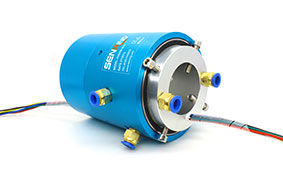How does a conductive slip ring work?
The working principle of conductive slip rings is mainly based on the conversion and induction of electromagnetic fields. Here's how it works in detail:Structure: The conductive slip ring is mainly composed of annular conductor, collector ring, rotating part and stationary part. The ring conductor is made of conductive material, such as copper or graphite, and its outer periphery is connected to the collector ring to maintain stability. The rotating part is driven by a mechanical device, allowing it to transmit current or signals while rotating.
How it works: When an electric current passes through a loop of conductor, it builds up a magnetic field. Due to the stable existence of the slip ring, this magnetic field does not rotate with the ring conductor. When the rotating part rotates, the magnetic field changes in space, and this change excites an induced current, allowing current or signals to be transmitted between the rotating part and the stationary part. This is the basic working principle of conductive slip rings.

In addition, conductive slip rings are usually made of conductive materials such as copper, silver, and gold, while carbon brushes are made of carbon materials. These materials have good electrical conductivity and wear resistance, which can ensure the long-term stable operation of the conductive slip ring. Conductive slip rings are widely used in various rotating equipment, such as wind turbines, machine tools, printing presses, cameras, etc. They can transmit electrical energy and signals and realize the electrical connection between rotating parts and stationary parts to ensure the normal operation of the equipment.

rotary electrical connector is a precision power transmission device used to transmit signals and electric energy. It uses the sliding contact of the variable ring and electromagnetic coupling to complete the transmission of electric energy and signals between the fixed frame, rotating parts and sliding parts. It mainly achieves 360-degree rotation through contact between the brush wire and the ring body to conduct electricity or transmit signals. One end is stationary and the other rotates with the device.

 RESOURCES
RESOURCES GET A QUOTE
GET A QUOTE





